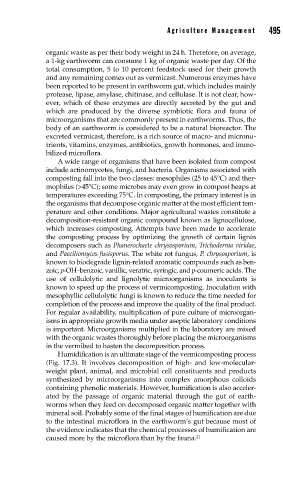Page 523 - Biosystems Engineering
P. 523
Agricultur e Management 495
organic waste as per their body weight in 24 h. Therefore, on average,
a 1-kg earthworm can consume 1 kg of organic waste per day. Of the
total consumption, 5 to 10 percent feedstock used for their growth
and any remaining comes out as vermicast. Numerous enzymes have
been reported to be present in earthworm gut, which includes mainly
protease, lipase, amylase, chitinase, and cellulase. It is not clear, how-
ever, which of these enzymes are directly secreted by the gut and
which are produced by the diverse symbiotic flora and fauna of
microorganisms that are commonly present in earthworms. Thus, the
body of an earthworm is considered to be a natural bioreactor. The
excreted vermicast, therefore, is a rich source of macro- and micronu-
trients, vitamins, enzymes, antibiotics, growth hormones, and immo-
bilized microflora.
A wide range of organisms that have been isolated from compost
include actinomycetes, fungi, and bacteria. Organisms associated with
composting fall into the two classes: mesophiles (25 to 45°C) and ther-
mophiles (>45°C); some microbes may even grow in compost heaps at
temperatures exceeding 75°C. In composting, the primary interest is in
the organisms that decompose organic matter at the most efficient tem-
perature and other conditions. Major agricultural wastes constitute a
decomposition-resistant organic compound known as lignocellulose,
which increases composting. Attempts have been made to accelerate
the composting process by optimizing the growth of certain lignin
decomposers such as Phanerochaete chrysosporium, Trichoderma viridae,
and Paeciliomyces fusisporus. The white rot fungus, P. chrysosporium, is
known to biodegrade lignin-related aromatic compounds such as ben-
zoic, p-OH–benzoic, vanillic, veratric, syringic, and p-coumeric acids. The
use of cellulolytic and lignolytic microorganisms as inoculants is
known to speed up the process of vermicomposting. Inoculation with
mesophyllic cellulolytic fungi is known to reduce the time needed for
completion of the process and improve the quality of the final product.
For regular availability, multiplication of pure culture of microorgan-
isms in appropriate growth media under aseptic laboratory conditions
is important. Microorganisms multiplied in the laboratory are mixed
with the organic wastes thoroughly before placing the microorganisms
in the vermibed to hasten the decomposition process.
Humidification is an ultimate stage of the vermicomposting process
(Fig. 17.3). It involves decomposition of high- and low-molecular-
weight plant, animal, and microbial cell constituents and products
synthesized by microorganisms into complex amorphous colloids
containing phenolic materials. However, humification is also acceler-
ated by the passage of organic material through the gut of earth-
worms when they feed on decomposed organic matter together with
mineral soil. Probably some of the final stages of humification are due
to the intestinal microflora in the earthworm’s gut because most of
the evidence indicates that the chemical processes of humification are
caused more by the microflora than by the fauna. 21

